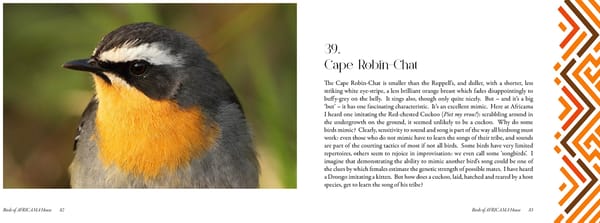39. Cape Robin-Chat The Cape Robin-Chat is smaller than the Ruppell’s, and duller, with a shorter, less striking white eye-stripe, a less brilliant orange breast which fades disappointingly to buffy-grey on the belly. It sings also, though only quite nicely. But – and it’s a big ‘but’ – it has one fascinating characteristic. It’s an excellent mimic. Here at Africama I heard one imitating the Red-chested Cuckoo (Piet my vrou!): scrabbling around in the undergrowth on the ground, it seemed unlikely to be a cuckoo. Why do some birds mimic? Clearly, sensitivity to sound and song is part of the way all birdsong must work: even those who do not mimic have to learn the songs of their tribe, and sounds are part of the courting tactics of most if not all birds. Some birds have very limited repertoires, others seem to rejoice in improvisation: we even call some ‘songbirds’. I imagine that demonstrating the ability to mimic another bird’s song could be one of the clues by which females estimate the genetic strength of possible mates. I have heard a Drongo imitating a kitten. But how does a cuckoo, laid, hatched and reared by a host species, get to learn the song of his tribe? Birds of AFRICAMA House 82 Birds of AFRICAMA House 83
 Birds of Africama 1 Page 41 Page 43
Birds of Africama 1 Page 41 Page 43